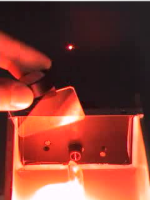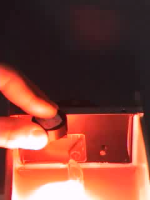2. Laser
Resonance
Light can therefore be amplified with the help of population inversion and stimulated emission. However, the resulting photons leave the laser medium quite quickly and do no more contribute to amplification, thus producing only short flashes of light. This type of laser is also known as a super emitter. Pulse lasers are widely used for lidar measurements, as already seen in chapter 1.
To achieve a continuous emission of laser light, the amplification must be maintained. This is done by two mirrors, one at each end of the laser medium. In the HeNe laser used in our experiment, the mirrors are found in the black-coloured, cylindrical ends of the tube. One mirror is not totally reflective but partly transparent (approx. 1 percent transmissivity), so that a large part of the photons remain contained within the laser medium, while a small number of photons exits through the partly transparent mirror as usable laser light.
The distance between the two mirrors is crucial in a laser because they work as resonators. Try to picture laser light with its characteristic wavelength. Similar to sound waves, a constructive interference of waves can occur when the resonator has a length of l=n λ (n being an integer number and λ the wavelength). Otherwise, a partial or total destructive interference of the waves takes place instead. The length of the resonator must be adapted perfectly to the laser wavelength. Only then is it possible to obtain a standing wave in the resonator, that is, a wave whose maxima and minima are stationary.
The photographs on the right show the effects of a glass plate in the laser's interior, or in other words, in the resonator itself.
If you hold the glass plate in the laser beam outside of the laser, you will observe no change in the intensity of the laser light. The loss is obvoiusly very minimal.
If you place the glass plate within the resonator, the laser ceases to emit light altogether. The slight weakening of the intensity caused by reflection on the glass surface is enough to impede the resonance within the laser.



The experiment can be seen more clearly in a Video (250 kB).
